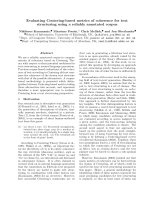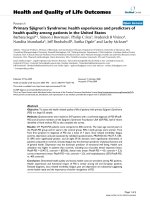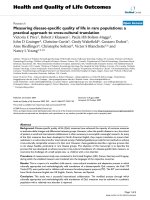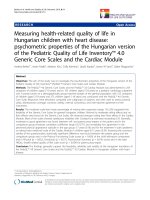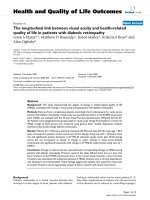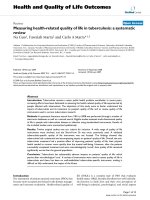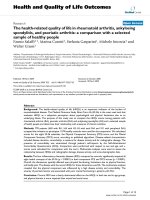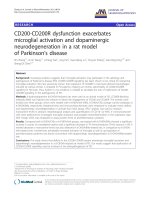báo cáo hóa học:" Uncontrolled asthma: assessing quality of life and productivity of children and their caregivers using a cross-sectional Internet-based survey" ppt
Bạn đang xem bản rút gọn của tài liệu. Xem và tải ngay bản đầy đủ của tài liệu tại đây (832.38 KB, 10 trang )
RESEARC H Open Access
Uncontrolled asthma: assessing quality of life and
productivity of children and their caregivers
using a cross-sectional Internet-based survey
Bonnie B Dean
1*
, Brian C Calimlim
1
, Patricia Sacco
2
, Daniel Aguilar
1
, Robert Maykut
3
, David Tinkelman
4
Abstract
Background: Results of a national survey of asthmatic children that evaluated management goals established in
2004 by the National Asthma Education and Prevention Program (NAEPP) indicated that asthma symptom control
fell short on nearly every goal.
Methods: An Internet-based survey was administered to adult caregivers of children aged 6-12 years with
moderate to severe asthma. Asthma was categorized as uncontrolled when the caregiver reported pre-specified
criteria for daytime symptoms, nighttime awakening, activity limitation, or rescue medication based on the NAEPP
guidelines. Children’s health-related quality of life (HRQOL) and caregivers’ quality of life (QOL) were assessed using
the Child Health Questionnaire Parent Form 28 (CHQ-PF28) and caregiver’s work productivity using a modified
Work Productivity and Activity Impairment Questionnaire. Children with uncontrolled vs. controlled asthma were
compared.
Results: 360 caregivers of children with uncontrolled asthma and 113 of children with controlled asthma
completed the survey. Children with uncontrolled asthma had significantly lower CHQ-PF28 physical (mean 38.1 vs
49.8, uncontrolled vs controlled, respectively) and psychosocial (48.2 vs 53.8) summary measure scores. They were
more likely to miss school (5.5 vs 2.2 days), arrive late or leave early (26.7 vs 7.1%), miss school-related activities
(40.6 vs 6.2%), use a rescue inhaler at school (64.2 vs 31.0%), and visit the health office or school nurse (22.5 vs
8.8%). Caregivers of children with uncontrolled asthma reported significa ntly greater work and activity impairment
and lower QOL for emotional, time-related and family activities.
Conclusions: Poorly controlled asthma symptoms impair HRQOL of children, QOL of their caregivers, and
productivity of both. Proper treatment and management to improve symptom control may reduce humanistic and
economic burdens on asthmatic children and their caregivers.
Background
In 2006 there were approxima tely 6.8 milli on children 17
years of age or younger with asthma in the United States
[1]. Nearly half of these c hildren (46.8%; 3.2 million)
were 5- 11 years old. With asthma being the third-ranked
cause of hospitalization among children younger than
15 years of age [2,3] and the leading cause among chil-
dren 3-12 years old [2,3], achieving adequate control of
asthma symptoms is imperative. Asthma has accounted
for more t han 14 mill ion school days missed each y ear
and has been linked to diminished school performance
[3-5]. It is the most common cause of school absenteeism
due to a chronic disease [6]. A d ecrease in the child’s
health-related quality of life ( HRQOL) and increase in
absenteeism may also affect the quality of life (QOL) and
work productivity of the child’s caregiver, w ho may lose
time from work, change to part-time employment, or
choose to not work at all to care for the child.
The last decade has seen a shift in the management of
asthma in clinical practice. Rather than managing
patients based on their severity, current clinical practice
guidelines emphasize that the overall goal of man age-
ment is to achieve symptom control [7]. Good asthma
control has been shown to be associated w ith improved
* Correspondence:
1
Cerner LifeSciences, Beverly Hills, CA, USA
Full list of author information is available at the end of the article
Dean et al. Health and Quality of Life Outcomes 2010, 8:96
/>© 2010 Dean et al; licensee BioMed Central Ltd. This is an Open Access article distributed under the terms of the Creative Commons
Attribution License ( .0), which permits unrestricted use, distribution, and reproduction in
any medium, provided the original work is properly cited.
health status [8]. The importance of symptom control in
children is underscor ed by the results of a national sur-
vey of asthmatic children that evaluated asthma manage-
ment goals established by the National Asthma
Education and Prevention Program (NAEPP) in 2004
[9]. The survey f ound that asthma control fell short on
nearly every goal, indicating the lack of effective asthma
symptom control in children.
This study was co nducted to evaluate the impact of
asthma symptom control upon the HRQOL of asthmatic
children, the QOL of the children’s caregivers, and the
productivity of the children with asthma as well as their
caregivers. We hypothesized that: 1) children whose
asthma disease state was not well controlled have a
decreased QOL and lower school productivity compared
to children with controlled asthma, and that 2) care-
givers of children whose asthma was not well controlled
have a decreased QOL and lower work productivity
compared to caregivers of children with controlled
asthma.
Methods
Study Design and Data Source
A random sample from a general registry of Internet
users who represented the United States (US) adult
population in terms of age, gender, geographic location,
and ethnicity was drawn in July 2007. This study was
approved by the Western Institutional Review Board
(WIRB). Prior to comple ting the survey, all respondents
were required to review and provide individual “sign-
off” on an IRB-approved electronic consent form, which
provided a brief background on the study, objectives
and risks of participation. Respondents also received
toll-free telephone numbers in case they needed to con-
tact the survey provider and/or the WIRB.
Participants were enrolled through e-mail invitations
sent by the registry management to households pre-
screened for registry participation. Inv itations were sent
to adults in households with at least one child younger
than the age of 18. The invitations asked adults to parti-
cipate in a cross-sectional Internet-based survey of care-
givers of asthmatic children aged 6-12. No attempt was
made to enlist participants from any particular demo-
graphic group or from those u nder the care of primary
care physicians or speciali sts. The following criteria
needed to be met by caregivers who opted to participate
in the survey and their children, respectively: the care-
giver had to be at least 18 years of age and living in the
US, and the caregiver’s child was required to be from 6
to 1 2 years of age, h ave a doctor’s diagnosis of asthma,
and have met predefined criteria for moderate to severe
asthma (asthma severity is defined below). If more than
one child qualified for the study, only the youngest child
meeting all the study criteria was included. Participants
received points for participation that could be redeemed
for items amounting to less than $5.
Asthma Severity
While many definitions of asthma severity have been
developed, none are consistently u sed, especially within
cross-sectional research. Assigning asthma severity in
observational studies is also complicated by the level of
symptom control achieved through controller medica-
tions. Even a patient without daily symptoms could
experience episodes severe enough to warrant an indica-
tion of moderate to high severity.
A pre-specified algorithm based on the child’shealth-
care utilization and current medications was used to
identify children with moderate to severe asthma. To
create this algorithm, caregiver-reported recent medica-
tion history was mapped to NAEPP 2002 medication
recommendations for the lowest treatment level
required to maintain symptom control [10]. Children
were classified as having moderate to severe asthma if
their caregiver reported ANY of the following criteria:
(a) an asthma-related hospitalization within the last
year; (b) an intensive care unit admission for asthma-
related symptoms within the last year; (c) the child
being placed on a ventilator during the last year; (d)
daily oral co rticosteroid use; (e) daily inhaled corticos-
teroid use at moderate to high doses according to
NAEPP 2002 medication recommendations; or (f) daily
use of low-dose inhaled corticosteroids along with any
of the followi ng medications: theophylline, leukotriene
receptor antagonist, cromolyn, or a long-acting
bronchodilator.
Asthma Symptom Control
Prior to the recent NAEPP guidelines, no clearly defined
method was published for assigning symptom control in
cross-sectional studies. The current guidelines provide
five criteria for assessing symptom control in asthma
patients. In this study, symptom control was determined
by question responses regarding four of the five key
symptom control expressions described in the NAEPP
2007 asthma guidelines [11]: prevention of daytime
symptoms, reduction of nocturnal awakening, infrequent
short-acting beta agonist use, and participation in nor-
mal activity levels. Forced expiratory volume in one sec -
ond is an office- or hospital-based m easure rather than
a symptom measure and thus was not collected in this
cross-sectional study.
Children were classified as having uncontrolled
asthma if their caregiver reported ANY one of the fol-
lowing criteria: (a) symptoms > 2 days per week; (b)
awakened by symptoms any night during the past
4 weeks; (c) any activity limitation (in kind or amount)
due to impairment or health problem; or (d) rescue
Dean et al. Health and Quality of Life Outcomes 2010, 8:96
/>Page 2 of 10
inhaler use > 5 times per week. All other children were
classified as having controlled asthma.
Health-related Quality of Life
The Child Health Questionnaire Parent Form 28 (CHQ-
PF28) was used to measure the HRQOL of the c hild
with asthma and the QOL of the child’s caregiver [12].
A generic HRQOL i nstrument, the CHQ-PF 28 is
designed to measure the HRQOL of children and the
QOL of their families across 13 scales. The following
nine scales mea sure the c hild’s HRQOL: physical func-
tioning (PF), role/social limitations-emotional/behavioral
(REB), rol e/social limitations-physical (RP), bodily pain/
discomfort (BP), behavior (BE), mental health (MH),
self-esteem (SE), general health (GH), and change in
health (CH). These scales are summarized into a physi-
cal summary measure (PHS) and a psychosocial sum-
mary measure (PSS). The impact of the child’s health on
the caregiver’s and family’s QOL is measured across the
remaining four scales: parental impact-emotional (PE),
parental impact-time (PT), family activities (FA), and
family cohesion (FC). With the exception of the CH
scale, which is analyzed as a categorical variable, all
scale measures are transformed to scores ranging from 0
to 100 and are analyzed as continuous variables. Sum-
mary measures are standardized with a mean of 50 and
standard deviation of 10 to reflect general US popula-
tion norms for children.
Child Productivity
The child’s school absenteeism and productivity were
assessed through question items including: absenteeism
in the previous year, late arrivals or early departures
from school, missed school-related activities, rescue
inhaler utilization at school, and visits to the health
office or school nurse because of asthma symptoms.
Caregiver Work Productivity
A disease-specific version of the Work Productivity
and Activity Impairment (WPAI) Questionnaire was
used to measure the impact of the child’ sasthmaon
the caregiver’ s productivity [13]. This instrument has
been modified in a number of disease areas to a ssess
disease-specific work productivity reductions, rather
than general work productivity reductions not necessa-
rily associated with a s pecific condition [14]. Addition-
ally, this i nstrument has been modified for use among
caregivers [15].
For this study, the instrument was modified to assess
impairment that the caregiver attributed to the child’s
asthma. The WPAI captured the work time absent,
impairment while working (presenteeism), overall work
productivity impairment, and regular daily activity (eg,
work around the house, shopping, studying, exercising)
assessed in the previous 7 days.
Data Analysis
The demographics of caregivers of children with uncon-
trolled versus controlled asthma were compared with
respect to their g ender, age, race/ethnicity, and geogra-
phical region. Children with uncontrolled versus con-
trolled asth ma were also compared on their gend er, age
and comorbid conditions. HRQOL and productivity dif-
ferences between children with uncontrolled and con-
trolled asthma and their respective caregivers were
analyzed. Differences in means were ev aluated using the
two-tailed t test procedure, and differences in propor-
tions were evaluated using Fisher’s exact test. Because
theCHscaleintheCHQ-PF28wasmeasuredasan
ordinal variable, the Cochran-Armitage test for trend
was used to assess differences between the groups.
Multiple comparison adjustment using the Bonferroni
procedure was made for the 13 domain measures and
two summary scales of the CHQ-PF28, all f ive child
productivity measure s assessed and all four measures of
the WPAI due to number of hypotheses tested simulta-
neously for these measures. For each statistical test, the
statistical level required to meet significance was
adjusted by the number of hypotheses tested in order to
raise the criteria for meeting significance . Although we
are not aware of any formal evaluations to determine
the minimal clinically important differences for the
CHQ-PF28, others have su ggested that most minimal
clinically important differences using QOL instruments
are centered around 0.5 standard deviation (SD) [12,16].
Guyatt’s responsiveness statistic (RS) [17], calculated
as a measure’s absolute difference between the uncon-
trolled and controlled groups divided by the standard
deviation of the controlled group, was used to describe
the effect siz e of the CHQ-PF28 physical summary mea-
sure (PHS) and psychosocial summary m easure (PSS)
between the uncontrolled and controlled children. Based
on the standard deviation criteria for minimally clini-
cally significant differences in HRQOL, an RS greater
than 0.5 was interprete d as a moderate effect size, while
a RS greater than 0.8 was interpreted as a large effect
size [18].
The difference in reduced work productivity between
caregivers of children with uncontrolled versus con-
trolled asthma was used to quantify the cost of reduced
work productivity due to uncontrolled asthma. Annual
cost calculations assumed 220 eight-hour paid working
days per year at an average annual salar y of $34,426 (or
a compensation rate of $19.56/hour) [19]. Statistical
analyses were performed using the SAS statistical pack-
age (SAS Version 9.1, SAS Institute, Cary, NC).
Dean et al. Health and Quality of Life Outcomes 2010, 8:96
/>Page 3 of 10
Results
Figure 1 is a flow chart describing the study participa-
tion. Invitations to participate in the survey were sent to
16,396 Harris Poll Online members, and 4,514 (25.7%)
initiated the survey scree ner (ie, logged onto the web
site) during t he 3-week fielding period during June
through July of 2007. From this pool of potential partici-
pants, participants were queried to identify those who
were 18 years of age, a US citizen, and the primary care-
giver to a child between the ages of 6 and 12 with
asthma within the household. A total of 473 satisfied
the study criteria, completed the questionn aire, and
were included in this analysis.
Caregiver Demographics
Of the adult caregivers that met the criteria to partici-
pate in this survey, 360 (76%) of 473 had a child classi-
fied with uncontrolled asthma. Caregiv er age, race/
ethnicity, and geographic region distributions were simi-
lar between caregivers of children with uncontrolled and
controlled asthma (Table 1). Caregivers of children with
uncontrolled as thma responding to this survey were
Figure 1 Study Participation Screening.
Dean et al. Health and Quality of Life Outcomes 2010, 8:96
/>Page 4 of 10
more likely to be female. Age and gender of children
with asthma did not differ statistically between the two
groups. Children with uncontrolled asthma were more
likely to have caregiver-reported sinusitis; other co-mor-
bidities we re reported with similar frequencies between
the groups. Only about one quarter of the children were
usually seen by a specialist (allergist, immunologist, or
pulmonologist). The majority of the children were
usually seen by their pediatrician or general practit ioner
for their asthma, and this did not vary by control status.
Out of the four criteria used to identify children with
uncontrol led asthma (Table 2), 81.4% would have quali-
fied for the uncontroll ed asthma category based on their
night awakenings alone. More than half of the c hildren
would have met the criteria for uncontrolled asthma
based solely on their activity limitation and nearly half
Table 1 Characteristics of Caregivers and Children by Asthma Symptom Control
Uncontrolled Controlled P value
N = 360 (%) N = 113 (%)
Caregiver-Specific Characteristics
Gender
Male 83 (23.1) 39 (34.5) 0.0190
Female 277 (76.9) 74 (65.5)
Age
Mean age (SD) 40.4 (9) 41.5 (8) 0.2428
Race/ethnicity
African American 23 (6.4) 7 (6.2) 0.4282
Asian/Pacific Islander 2 (0.6) 2 (1.8)
Caucasian 312 (86.7) 94 (83.2)
Hispanic 9 (2.5) 3 (2.7)
Native American 5 (1.4) 2 (1.8)
Other 7 (1.9) 2 (1.8)
Decline to answer 2 (0.6) 3 (2.7)
Region
South 144 (40.0) 39 (34.5) 0.6104
West 63 (17.5) 18 (15.9)
Northeast 65 (18.1) 23 (20.4)
Midwest 88 (24.4) 33 (29.2)
Child-Specific Characteristics
Gender
Male 216 (60) 78 (69) 0.0956
Female 144 (40) 35 (31)
Age
Mean age (SD) 9.1 (2) 9.1 (2.1) 0.2428
Type of Physician
Pediatrician 198 (55) 56 (49.6)
Family practitioner/general practitioner/internist 63 (17.5) 20 (17.7) 0.82
Allergist 55 (15.3) 21 (18.6)
Immunologist 4 (1.1) 1 (0.9)
Pulmonologist 40 (11.1) 15 (13.3)
Comorbid Conditions
Eczema or atopic dermatitis 91 (25.3) 26 (23) 0.7081
Hay fever (seasonal allergic rhinitis) 157 (43.6) 39 (34.5) 0.1006
Rhinitis 35 (9.7) 10 (8.8) 0.8562
Sinusitis 87 (24.2) 13 (11.5) 0.0036
Allergies 265 (73.6) 83 (73.5) 1.0000
Gastroesophageal reflux disease 37 (10.3) 6 (5.3) 0.1337
None of these 58 (16.1) 17 (15) 0.8830
Dean et al. Health and Quality of Life Outcomes 2010, 8:96
/>Page 5 of 10
based solely on their daytime symptoms. Caregivers
reported that nearly 59.7% of children with uncontrolled
asthma met at least two criteria for uncontrolled asthma
and one fifth met at least three of the four criteria.
Health-related Quality of Life
Among the nine doma ins evalua ting the HRQOL of the
child, children with uncontrolled asthma had signifi-
cantly worse CHQ-PF28 measures across seven (PF,
REB, RP, BP, BE, MH, and SE) when compared with
children with controlled asthma (Figure 2). No signifi-
cant difference was observed in the remaining two scales
of change in health and general health. Significant dif-
ferences were observed in both summary measures;
lower mean physical and psychosocial summary measure
scores were observed for children with uncontrolled
asthma as compared to those whose asthma was con-
trolled by 11.7 points (SE = 1.2, RS = 2.4) and 5.6 points
(SE = 1.1, RS = 0.7), respectively (Figure 2). Standar-
dized mean summary scores for children with controlled
asthma were within the expected range of population
norms (mean = 50, SD = 10) and were within the range
for most domains of those scores reported for a large
sample of children with no conditions. The mean physi-
cal summary scale score for children with uncontrolled
asthma was greater than one standard deviation below
expected population norms.
A similar impact was observed in the QOL of the
child’s caregiver and family. Significantly lower scores
were observed across three of the four caregiver and
family QOL measures (Figure 2). Relative to the mean
response of caregivers of children with co ntrolled
Table 2 Criteria for Meeting the Definition of
Uncontrolled Asthma
Uncontrolled Asthma
N = 360
Criteria n (%)
Daytime symptoms 157 (43.6)
Night awakenings 293 (81.4)
Short-acting beta agonist utilization 36 (10.0)
Activity limitation 185 (51.4)
2 or more criteria 215 (59.7)
3 or more criteria 75 (20.8)
All 4 criteria 21 (5.8)
Figure 2 CHQ-PF28 Scores by Asthma Symptom Control. All values are displayed as mean (SD).
‡
P ≤ 0.005.
§
P ≤ 0.0001
Dean et al. Health and Quality of Life Outcomes 2010, 8:96
/>Page 6 of 10
asthma, the mean response of caregivers of children
with uncontrolled asthma was lower across the parental
impact-emotional, parental impact-time and family
activities scales (all P < 0.0001), with significant differ-
ences of 26.9%, 18.4%, and 22.6%, resp ectively. The 3.5%
(2.6 points) lower family cohesion scale score observed
in the uncontrolled asthma group was not large enough
to conclude that an assoc iation existed between family
cohesion and asthma control status.
Child Productivity
Approximately half (50.4%) of the caregivers of children
with controlled asthma reported that their child had
missed a day of school due t o asthma in th e past year,
while 64.4% of caregivers of children with uncontrolled
asthma reported asthma-related absenteeism. On aver-
age, children with uncontrolled asthma were reported to
miss significantly more days of school (5.5 days, SD =
7.7) than children with controlled asthma (2.2 days, SD
= 3.7). Furthermore, compared to the caregivers of chil-
dren with controlled asthma, a significantly greater per-
centage of caregivers of children with uncontrolled
asthma reported that their child arrived late or departed
early from school, missed school-related activities, used
a rescue inhaler at school, and visited the health office
or school nurse because of asthma symptoms (Figure 3).
Caregiver Productivity
No significant difference was observed in t he employ-
ment status of caregivers of children with uncontrolled
versus controlled asthma: 31.7% vs. 29.2% unemployed,
respectively. Restricting the analysis to caregivers of
children with controlled and uncontrolled asthma who
reported employment (n = 246 [68.3%] and n = 80
[70.8%], respectively), caregivers of children with uncon-
trolled asthma reported a significa ntly greater work pro-
ductivity impairment due to the child’sasthmaacross
three of the four WPAI measures (Figure 4). On aver-
age, these e mployed caregivers of children with uncon-
trolled asthma reported nearly three times more work
time absent than that reported by caregivers of children
with controlled asthma, but due to the reduced sample
size in this analysis, especially within the control group,
this difference was not large enough to allow a conclu-
sion of statistical significance. Productivity while work-
ing was significantly reduced by 12.7% among caregivers
of children with uncontrolled asthma versus 4.9%
among caregivers of children with controlled asthma.
Caregivers of children with uncontrolled asthma also
reported a significant work productivity impairment that
was 10.2% greater than the impairment reported by
caregivers of children with controlled asthma, represent-
ing 4.1 hours of additional productivity los s per 40-hour
work-week. Furthermore, regular daily activity impair-
ment due to the child’s asthma was significantly greater
in caregivers of children with uncontrolled asthma.
Discussion
It has been shown that asthma can have a profound
impact on children. Uncontrolled asthma symptoms not
only affect children physically but can impair them
socially, emotionally, and educationally. However, the
impact of asthma in children extends to their caregivers
and families, who face the burden of care and impact on
Figure 3 School Related Measures by Asthma Control.*P < 0.0001.
‡
P ≤ 0.005
Dean et al. Health and Quality of Life Outcomes 2010, 8:96
/>Page 7 of 10
lifestyle. Achieving optimal asthma control can reduce
the impact of symptoms on the daily functioning of the
child in addition to the caregivers and other family
members.
By surveying caregivers of children with moderate to
severe asthma, we evaluated the impact of uncontrolled
asthma on children and their caregivers among a random
sample from a general registry of Internet users represen-
tative of the US adult population. In this study, the fre-
quency and severity of s ymptoms were sufficient that
three quarters (76%) could be classified as uncontrolled.
Given that uncontrolled asthma is reported at approxi-
mately 60% in general practice populations [20,21], the
high rate of uncontrolled symptoms among children with
moderate to severe asthma in this study is not completely
unexpected and highlights the under-management of
asthma in the pediatric population [11]. Although studies
such as this one indicate that symptom control is
achieved far less optimally in real world practice settings,
it has been shown that asthma control can be achieved
and maintained in the majority of patients [22].
Children with uncontrolled asthma had significantly
lower HRQOL scores across seven of nine CHQ-PF28
domains relating to the physical, emotional, and social
well-being of the child, demonstrating the extent of the
effect of uncontrolled symptoms on the c hild. Within
the s chool experience, children w ith uncontrolled
asthma missed a significantly greater number of school
days than their controlled counterparts. Even when chil-
dren were present within school, results suggest that
children whose asthma disease state is not w ell con-
trolled miss more classes due to arriving late, leaving
early, and visiting the health office and school nurse,
and miss more school-related activities compared to
children with controlled asthma. Given the impact
asthma has on school, creating and utilizing individual
asthma action plans within the school and maintaining
communication between teachers and caregivers should
be considered a part of the child’s treatment plan.
Uncontrolled pediatric asthma also had a negative
impact on the family and caregivers. Although caring
for a child with asthma requires caregiver time, and
families of children with controlled asthma must avoid
some types of activities, caregivers of children with
uncontrolled asthma report even lower HRQOL scores
than those reported in controlled asthma, suggesting
that uncontrolled asthma exacts an even greater toll on
the caregiver and families.
The effects of uncontrolled asthma on the caregiver
extend beyond the social and emotional impact. Among
employed caregivers, work pro ductivity impairment was
significantly greater among parents of children with
uncontrolled asthma. Compared with employed care-
givers of children with controlled asthma, employed
caregivers of children with uncontrolled asthma had an
additional 10.2% overall work productivity impairment.
This difference amounts to an average cost of $3,511 in
estimated annual incremental costs above that seen in
employed caregivers of children with control led asthma.
Findings from this study suggest that children with
uncontrolled asthma a re far m ore likely to experience
asthma-related nighttime awakenings, and it is not at all
unlikely that their caregivers too are awakened more
often at night. This could be a driving factor in impaired
Figure 4 Mean WPAI Scores for Employed Caregivers by Asthma Control.*P <0.0001.
†
P ≤ 0.005. Note: Analysis only incl udes caregivers
reporting employment (n = 246 uncontrolled, n = 80 controlled)
Dean et al. Health and Quality of Life Outcomes 2010, 8:96
/>Page 8 of 10
work performance the next day. With decreased overall
productivity and the concerns of caring for their child,
issues of job security may also be of concern for parents.
A number of studies have highlighted an association
between increasing asthma severity in children and
reduced quality of life and absenteeism while others
have found differing results [23,24]. Some of this discre-
pancymaybeduetoinconsistenciesinthemethods
and criteria used to define asthma severity. With the
shift from asthma severity to asthma control in the diag-
nosis and management of asthma, a greater need for
measuring and understanding the burden of uncon-
trolled asthma is essential. This study provides a method
for defining asthma control that closely follows criteria
outlined in the NAEPP 2007 asthma guidelines [11].
Findings from this study support those reported by
others, reflecting that better asthma control is associated
with better outcomes [25,26].
[22]This study relied on the information provided by
primary caregivers for their children with asthma. The
same is true for p hysicians of pediatric patients, w ho
have to obtain their information regarding symptom
control from the caregivers. It is essential for physicians
to provide the tools for these caregiv ers on how to
observe their children and monitor their asthma symp-
toms. Physicians and parents need to communicate and
work together to establish control over asthma and
monitor closely when this state changes. Physicians can
help the caregivers in this process by providing direction
through a written action plan.
This research has some limitations. As mentioned pre-
viously, the use of an Internet population may limit the
ability to generalize the results of this study. Typically,
Internet users tend to have higher education and
income than the general population among other differ-
ences, and the prev alence and impact of uncon trolled
asthma may be worse for patients and families with
lower income and less access to health care. However,
web-based surve ys are increasing in popularity as a
means of reaching large numbers of patients even in the
area of asthma [27], and research evaluating web-based
surveys among general research panels against other epi-
demiologic forms of data collection suggest their com-
parability [28,29]. The response rate in this study–25%–
compares well with other web-based surveys as sug-
gested by the 26. 5% median re sponse rate (meaning th at
half of all surveys get at least a 26.5% response rate)
that was reported in a recent white paper written for
industry guidance for online survey use [30]. Addition-
ally, it should be pointed out that participation of
patients with controlled and uncontrolled asthma would
likely not be different ially biased since all respondents
were from the same internet pool; care should be taken
when generalizing to the broader population.
As with any survey, recall bias may affect interpretation
of results. Caregivers of children with uncontrolled asthma
may be uniquely aware, and therefore have differing recall,
of their child’s symptoms and measured outcomes. In
addition, this study used a generic HRQOL instrument
and a modi fied version of a p roductivity instrument to
determine asthma-specific impact of disease control on
children and caregivers. A generic HRQOL instrument
was chosen in part because this survey was completed by
caregivers on behalf of their children rather than by direct
child assessment and because few disease-specific instru-
ments allow for HRQOL among young children reported
by their caregivers. Although the WPAI has been modified
and validated in a number of disea se areas and for use
among caregivers, the caregiver asthma-specific version
has not undergone formal validation. The inclusion of chil-
dren w ith moderate to severe asth ma in this study was
based on patterns o f medica tion and utilization reported
during the previous 6 months. The use of medica tions to
classify asthma severity can be complicated and is based
on assumptions about treatment adequacy that cannot be
verified within the current study design. Lastly, based on
the N AEPP guidelines, the reporting of interference with
normal activities was use d to classify asthma control status.
However, interference with normal activities is also a
strong component of HRQOL and thus we may have influ-
enced the inter-group comparison of HRQOL measures
based on the defin ition of uncontrolled asthma alone.
The algorithm for symptom control used in this study
was determined by question responses regarding key
symptom control expressions described in the NAEPP
2007 asthma guidelines. However, recruitment for this
study began prior to the release of the NAEPP update
in August 2007. As such, response options for frequency
of rescue inhaler use did not map exactly to the limits
set forth in the current guidelines. We chose to use a
more conservative measure of rescue inhaler use (ie, a
greater frequency of usage) to categorize control, which
may have led to some children being misclassified as
controlled, thus underestimating the differences between
children with uncontrolled and controlled asthma.
Conclusion
In conclusion, caregivers of children with asthma face
many challenges and can also be profoundly impacted
by their child’s illness. Uncontrolled asthma has a signif-
icant impact on the HRQOL and productivity of chil-
dren and on the QOL and work productivity of their
caregivers, and has an impact on their families.
Abbreviations
BP: bodily pain/discomfort; BE: behavior; CH: change in health; CHQ-PF28:
Child Health Questionnaire Parent Form 28; FA: family activities; FC: family
cohesion; GH: general health; HRQOL: health-related quality of life; MH:
Dean et al. Health and Quality of Life Outcomes 2010, 8:96
/>Page 9 of 10
mental health; NAEPP: National Asthma Education and Prevention Program;
PE: parental impact-emotional; PF: physical functioning; PHS: physical
summary measure; PSS: psychosocial summary measure; PT: parental impact-
time; QOL: quality of life; REB: role/social limitations-emotional/behavioral; RB:
role/social limitations-physical; RS: Guyatt’s responsiveness statistic; SE: self-
esteem; also standard error; US: United States; WPAI: Work Productivity and
Activity Impairment
Acknowledgements
The research presented in this paper was supported by an unrestricted
grant from Novartis Pharmaceuticals Corporation (Novartis).
Author details
1
Cerner LifeSciences, Beverly Hills, CA, USA.
2
Global Health Economics and
Outcomes Research, Novartis Pharmaceuticals Corporation, East Hanover, NJ,
USA.
3
US Clinical Development & Medical Affairs, Novartis Pharmaceuticals
Corporation, East Hanover, NJ, USA.
4
Department of Pediatrics, National
Jewish Medical and Research Center, Denver, CO, USA.
Authors’ contributions
Each author has participated in the concept and design; analysis and
interpretation of data; drafting or revising of the manuscript and each
author has read and approved the manuscript as submitted. Each author
has disclosed any affiliation, financial agreement, or other involvement with
any company whose product figures prominently in the submitted
manuscript so that the editors can discuss with the affected authors
whether to print this information and in what manner.
Competing interests
The research presented in this paper was supported by an unrestricted
grant from Novartis Pharmaceuticals Corporation (Novartis). BBD, DA and
BCC are employed by Cerner LifeSciences, which provides consulting
services to the pharmaceutical industry. RM and PS are employees of
Novartis and therefore receive compensation from the study sponsor in the
form of personal wages and in equity/ownership (e.g., company stock) in
the company.
Received: 16 February 2010 Accepted: 8 September 2010
Published: 8 September 2010
References
1. Bloom B, Cohen RA: Summary health statistics for U.S. children: National
Health Interview Survey, 2006. Vital Health Stat 2007, 10:1-87.
2. Owens PL, Thompson J, Elixhauser A, Ryan K: Care of Children and
Adolescents on US Hospitals. HCUP Fact Book No. 4. AHRQ Publication
No. 04-0004. Department of Health and Human Services. 2003, 7-5-2007.
3. Environmental Hazards and Health Effects: Asthma’s Impact on Children
and Adolescents. Department of Health and Human Services, Centers
for Disease Control and Prevention. 2002, 7-20-2007.
4. Diette GB, Markson L, Skinner EA, Nguyen TT, Algatt-Bergstrom P, Wu AW:
Nocturnal asthma in children affects school attendance, school
performance, and parents’ work attendance. Arch Pediatr Adolesc Med
2000, 154 :923-928.
5. Asthma Prevalence, Health Care Use and Mortality, 2002. National
Center for Health Statistics, Centers for Disease Control. 2002, 7-20-2007.
6. The Costs of Asthma; Asthma and Allergy Foundation 1992 and 1998
Study. 2000.
7. Pedersen S: From asthma severity to control: a shift in clinical practice.
Prim Care Respir J 2010, 19:3-9.
8. Bateman ED, Bousquet J, Keech ML, Busse WW, Clark TJ, Pedersen SE: The
correlation between asthma control and health status: the GOAL study.
Eur Respir J 2007, 29:56-62.
9. Children and Asthma in America. [], [Last
updated May, 2004]. 2004. 4-21-2008.
10. NAEPP (National Asthma Education and Prevention Program). Guidelines
for the Diagnosis and Management of Asthma, Update on Selected
Topics. Bethesda, MD. National Institutes of Health. National Heart, Lung,
and Blood Institute 2002, 4-15-2008.
11. NAEPP (National Asthma Education and Prevention Program). Guidelines
for the Diagnosis and Management of Asthma, Full Report 2007.
Bethesda, MD. National Institutes of Health. National Heart, Lung, and Blood
Institute 2007, 5-15-2009.
12. Raat H, Botterweck AM, Landgraf JM, Hoogeveen WC, Essink-Bot ML:
Reliability and validity of the short form of the child health
questionnaire for parents (CHQ-PF28) in large random school based and
general population samples. J Epidemiol Community Health 2005, 59:75-82.
13. Reilly MC, Bracco A, Ricci JF, Santoro J, Stevens T: The validity and
accuracy of the Work Productivity and Activity Impairment
questionnaire–irritable bowel syndrome version (WPAI:IBS). Aliment
Pharmacol Ther 2004, 20:459-467.
14. Kronborg C, Handberg G, Axelsen F: Health care costs, work productivity
and activity impairment in non-malignant chronic pain patients. Eur J
Health Econ 2009, 10:5-13.
15. Giovannetti ER, Wolff JL, Frick KD, Boult C: Construct validity of the Work
Productivity and Activity Impairment questionnaire across informal
caregivers of chronically ill older patients. Value Health 2009,
12:1011-1017.
16. Norman GR, Sloan JA, Wyrwich KW: Interpretation of changes in health-
related quality of life: the remarkable universality of half a standard
deviation. Med Care 2003, 41:582-592.
17. Guyatt G, Walter S, Norman G: Measuring change over time: assessing the
usefulness of evaluative instruments. J Chronic Dis 1987, 40:171-178.
18. Cohen J: Statistical power analysis for the behavioral sciences. Hillsdale,
NJ: Lawrence Erlbaum Associates, 2 1988.
19. Occupational Employment Statistics. May 2007 National Occupational
Employment and Wage Estimates. United States. Bureau of Labor
Statistics. 2007, 12-9-2008.
20. van den Nieuwenhof L, Schermer T, Heins M, Grootens J, Eysink P,
Bottema B, et al: Tracing uncontrolled asthma in family practice using a
mailed asthma control questionnaire. Ann Fam Med 2008, 6(Suppl 1):
S16-S22.
21. Chapman KR, Boulet LP, Rea RM, Franssen E: Suboptimal asthma control:
prevalence, detection and consequences in general practice. Eur Respir J
2008, 31:320-325.
22. Bateman ED, Boushey HA, Bousquet J, Busse WW, Clark TJ, Pauwels RA,
et al: Can guideline-defined asthma control be achieved? The Gaining
Optimal Asthma ControL study. Am J Respir Crit Care Med 2004,
170:836-844.
23. Moonie SA, Sterling DA, Figgs L, Castro M: Asthma status and severity
affects missed school days. J Sch Health 2006, 76:18-24.
24. Everhart RS, Fiese BH: Asthma severity and child quality of life in
pediatric asthma: a systematic review. Patient Educ Couns 2009,
75:162-168.
25. Schmier JK, Manjunath R, Halpern MT, Jones ML, Thompson K, Diette GB:
The impact of inadequately controlled asthma in urban children on
quality of life and productivity. Ann Allergy Asthma Immunol 2007,
98:245-251.
26. Williams SA, Wagner S, Kannan H, Bolge SC: The association between
asthma control and health care utilization, work productivity loss and
health-related quality of life. J Occup Environ Med 2009, 51:780-785.
27. Weisel CP, Weiss SH, Tasslimi A, Alimokhtari S, Belby K: Development of a
Web-based questionnaire to collect exposure and symptom data in
children and adolescents with asthma. Ann Allergy Asthma Immunol 2008,
100:112-119.
28. Harris KM, Schonlau M, Lurie N: Surveying a nationally representative
internet-based panel to obtain timely estimates of influenza vaccination
rates. Vaccine 2009, 27:815-818.
29. Heeren T, Edwards EM, Dennis JM, Rodkin S, Hingson RW, Rosenbloom DL:
A comparison of results from an alcohol survey of a prerecruited
Internet panel and the National Epidemiologic Survey on Alcohol and
Related Conditions. Alcohol Clin Exp Res 2008, 32:222-229.
30. Hamilton MB: Online survey response rates and times; background and
guidance for industry. Ipathia, Inc./SuperSurvey 2009.
doi:10.1186/1477-7525-8-96
Cite this article as: Dean et al.: Uncontrolled asthma: assessing quality
of life and productivity of children and their caregivers using a cross-
sectional Internet-based survey. Health and Quality of Life Outcomes 2010
8:96.
Dean et al. Health and Quality of Life Outcomes 2010, 8:96
/>Page 10 of 10
